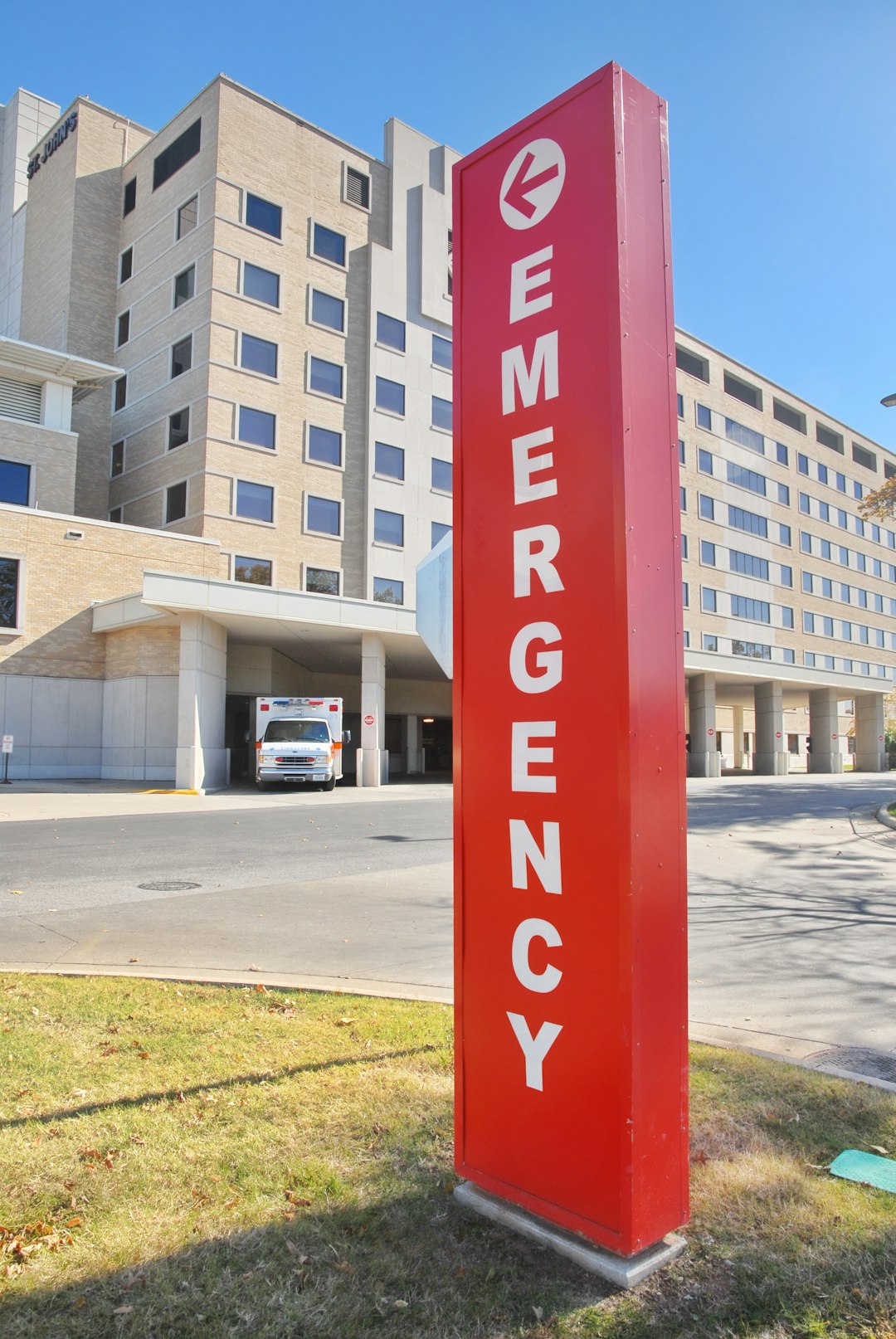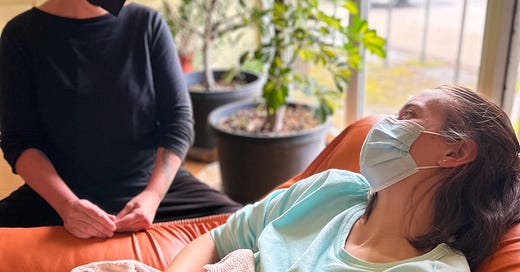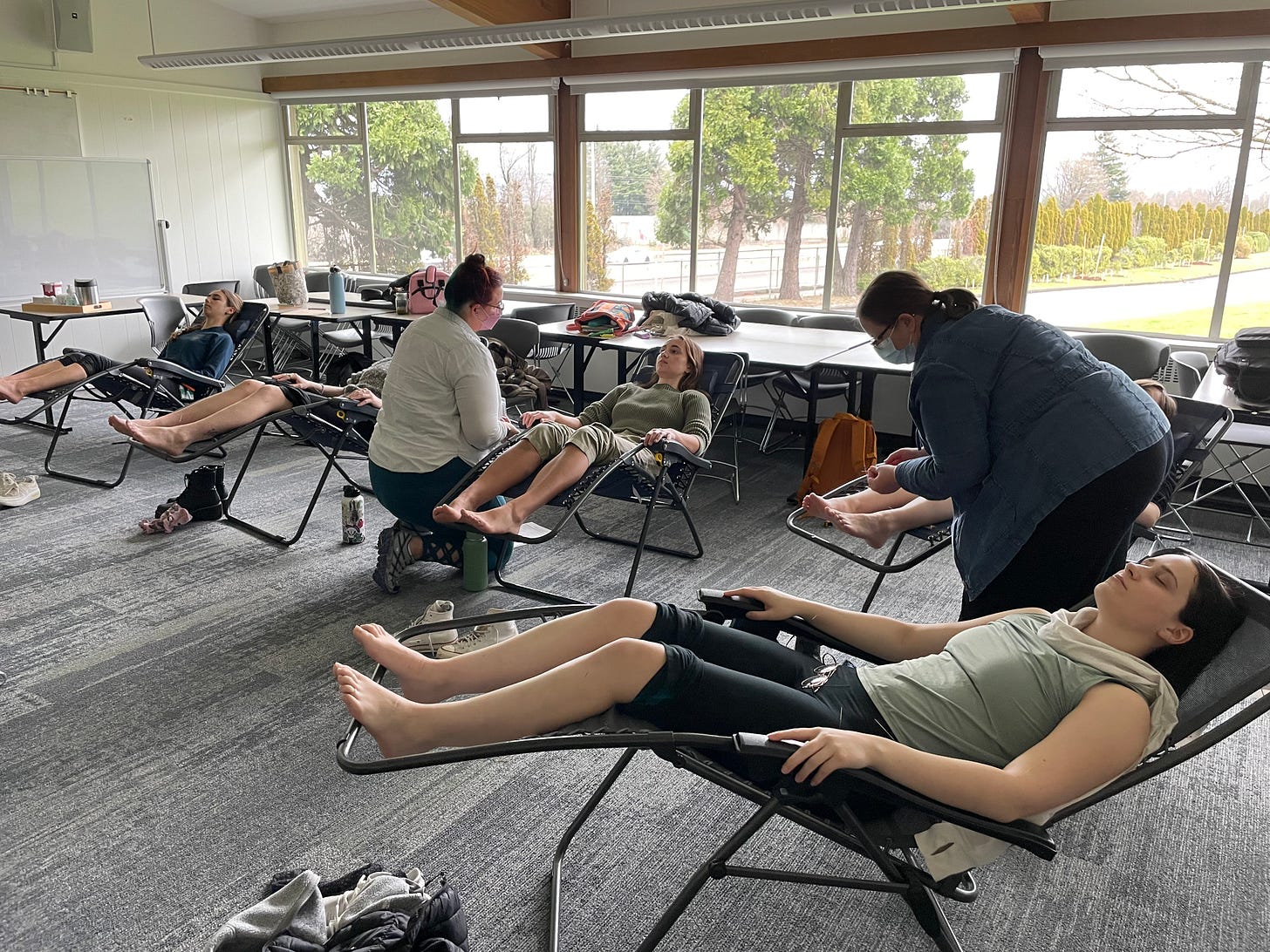Why Nurses Love Community Acupuncture, Part 2: Trauma-Informed Care
a guest post by Jennifer Kehl RN
As part of WCA’s coaching process for strategic partnerships, Camille encouraged us to define exactly what WCA has to offer our partners. At the top of that list is trauma-informed acupuncture. We originally learned about the concept of trauma-informed care from the caseworkers of Care Oregon’s hotspotting program back in 2012 — a great gift of that partnership.
It wasn’t something we learned in acupuncture school, and it’s yet another reason we felt like we had to make our own school, so that we can orient students toward it from the very beginning of their education. Sometimes people think “trauma-informed” is just an empty buzzword. There’s a LOT to say about why trauma-informed acupuncture is vital to WCA and its partnerships (stay tuned). I asked third-year POCA Tech student Jennifer Kehl to introduce the topic based on her experience with nursing. I really appreciate her perspective and I hope you do too!

If you ask an ER nurse to be “trauma informed” I can promise that you will witness the biggest eye roll you’ve ever seen. They hate buzzwords. They’ll immediately get defensive. “What do you mean? I’m not nice enough?” Then they’ll get angry. “Well maybe if I didn’t have to do all this charting and if we had more staff….and also, you have no idea what we deal with down here!”
(Sounds like someone’s been triggered!)
The truth is, ER folks do trauma informed care every day, all day long. They get really good at it, and they screw it up a lot too. I called it “Lessons in Boundaries”. We begin to see why those boundaries exist for people when we start thinking in terms of “What happened to you?” instead of “What’s wrong with you?”.
Trauma informed care assumes that every person may have a trauma history, and as caregivers, we may re-traumatize them without meaning to, even if our hearts are in the right place.
Looking back, every time I’ve been hit, kicked, slapped, or spit on, I was in a weakened state myself. My own boundaries were failing me. Maybe I didn’t get a break and I was hungry, maybe I was annoyed at staffing, maybe it was just the end of a twelve hour shift and my feet hurt. Regardless, I didn’t take the time to check myself. I didn’t pay attention to my patient closely enough to realize I was stepping on boundaries. I didn’t notice they were starting to get triggered. Maybe I myself got triggered.
It’s important to remember that we are also people! We may also have a trauma background. We get triggered too! Forgive yourself! Luckily, once we know what our own triggers are, it’s easier to consciously side step into our professional persona when we need to and be there for our patient.
Triggers are everywhere in a healthcare setting, and navigating a patient's boundaries without creating an adversarial relationship takes work.
I consider it a lifelong project. Trauma informed care offers five guiding principles that allow us to respect people’s boundaries and hopefully avoid some of those triggers:
1. People need to feel safe (physically and emotionally). This includes things like: not sneaking up on people, asking them if it’s OK before you touch them, and avoiding intrusive personal questions that may make them feel judged or vulnerable.
2. People need to know that they have choices, and that when it comes to their bodies and their health, nothing will be forced on them.
3. Collaboration is important. People want to play an active part in their plan of care. They want to know that you hear their questions and concerns.
4. People need to trust us. They won’t do that if we are inconsistent in our messages, or if we are not transparent about our plans and motivations.
5. People need to feel empowered to take charge of their own health. We can help them by sitting beside them and accompanying them through their healthcare experience, rather than using our status as an authority figure to manipulate the situation.
Unfortunately, even if we tattoo the five principles on our forearms, it can be hard to apply them in our current healthcare system. Here’s one example where well meaning entities have set up a process that not only doesn’t make sense at the ground level, but has nurses stepping all over boundaries.
Because the ER is a big safety net, and they have access to so many people each day, regulatory agencies decided to use this net to try to catch all the things that a patient might be struggling with. The ER can be a one stop shop for all things “wrong with you”.
Shockingly, all the extra work fell on the already beleaguered triage nurse. They call it the “Triage Risk Assessment Screening”. It’s brilliant!!! Medicare and Medicaid will be so happy and it will look like we care about these things!!!! Right?!
What this looks like in practice:
Me: “Hi! How can we help today?”
Patient: “I think I broke my wrist skateboarding!”
Me: “Oh no! Let’s take a look…OK, we’ll get you back into a room as soon as we can. Unfortunately it might be awhile, so we’ll get an Xray ordered and I’ll go grab you an ice pack…
Oh wait — first I need to ask you some questions.”

1. “In the past month have you wished you were dead or wished you could go to sleep and never wake up?”
2. “In the past month have you had any actual thoughts of killing yourself?”
3. “Do you feel safe at home?”
4. “Do you feel safe in your current relationship?”
5. “Is there anyone in your life who is hurting you?”
6. “Are you currently in recovery?”
7. “How many times in the past year have you had 4 or more drinks in a day?”
8. “How many times in the past year have you used a recreational drug or used a prescription medication for something other than its intended use?”
9. “Do you have anything with you that can be used as a weapon?”
These are the actual screening questions used at my local ER.
The triage nurse is required to ask each of these questions for every single patient that comes through the door. As you can imagine, in a busy ER lobby, there is just no way to ask these questions in a trauma-informed way. What would have been a caring and compassionate five minute triage, turns into a lengthy, awkward and intrusive interaction. Any rapport that had been built is gone. The patient walks away bewildered, or triggered, or worse. It sets up the scene for an angry, heated interaction four or five hours later when the patient finally gets fed up and throws a chair across the room.
Many people that come into the ER are struggling with substance abuse, mental illness, and/or a history of trauma. For them, having a stranger confront them with these realities is not only triggering, but it’s disrespectful and totally pointless.
The acupuncture world has its own set of intrusive questions.
A standard Traditional Chinese Medicine treatment includes “10 Questions”, which are really “10 categories”, each having their own set of even more questions. Patients can be caught off guard by these sometimes extremely personal questions, especially when they don’t seem at all related to why they came in for treatment.
A good friend of mine told me he was seventeen when he had his one and only experience with acupuncture. His mother made him go to see if it would help with his depression. One of the first questions the acupuncturist asked him was “How many times a day do you masturbate?” His response was “I’m seventeen! What do you think?!” I assured him that if he came into the clinic, I would never ask him this! Nor do I care.
Most acupuncture schools focus a lot of time and energy on teaching students how to conduct these lengthy interviews. Patients can get triggered if it’s not information they feel comfortable sharing, and unless they are familiar with Chinese medicine, the questions may not even make sense to them. This can be a very uncomfortable place to be for someone with a trauma history.
POCA Tech and WCA don’t encourage the practice of gaining information that may or may not even be helpful at the risk of triggering the patient.
Giving lifestyle advice is another standard acupuncture practice that WCA and POCA Tech try to steer clear of. Advice like this can feel confrontational to people who may feel shame or guilt about their lifestyle choices. It’s hard to imagine someone struggling with substance abuse or mental illness wanting to return to a place where they are told to “just start living your life better”.
I think healthcare gets it all wrong when it comes to these things. Whether it be western or eastern medicine, the idea is “do these things, and then you’ll be healthier and feel better”. There’s a logic to that for sure, but I personally don’t see it work for the long run.
I like to switch it around and say “feel better, and then maybe you’ll have the energy and motivation to take charge of your health and start doing things to keep you feeling better.”
This is where community acupuncture really shines. It gets you feeling better.
Let’s take a look at how the five guiding principles of trauma informed care (safety, choice, collaboration, trustworthiness, and empowerment) are put into practice in a community acupuncture clinic.
Community acupuncture clinics by design offer a level of safety. Instead of being led into an empty room, patients wander into a space where people are already resting. The expectation is: “This is a place for you to relax.” Patients aren’t alone in a room with the acupuncturist. They are never required to remove any clothing. Touching, in general, is very limited and the clinic culture emphasizes the need for consent. Quietly, the community acupuncturist asks open-ended questions like “What would you like to focus on today?”. Patients only need to divulge what they feel like talking about that day. Acupuncturists don’t pry or question their lifestyle.
Patients have choices in a community acupuncture clinic. It can feel refreshing for those who live with the stigma of poverty to be able to pay just what they can afford without having to provide any kind of “proof of poverty” or fill out a bunch of forms.
As they drift through the space, they can pick out a chair that is just right for them. Maybe they like to be able to see the exit because of past experiences of feeling trapped. Maybe they like to hole up in a corner where they can feel snug and secure. Maybe they like to be in the center of the room where they can listen to the stirrings of their fellow humans and not feel so alone. At WCA they even get to decide how long they would like to relax.
Collaboration begins the moment the acupuncturist rolls up to their chair. The patient’s input about the treatment is valued. Focus is on accompanying the patient towards their healthcare goals, as opposed to giving advice and directives. Discussions between acupuncturist and patient center on how the patient would like to use the clinic, and how to integrate what the clinic has to offer into their life.
Community acupuncture clinics are consistent. The order of operations is exactly the same each time. No surprises! This builds trust. Patients know exactly what to do when they come in, and they know it will be the same next time. Even transparency is built right into a community setting. Patients can see that the acupuncturist does the same job, the same way, with each patient.
Empowerment happens when caregivers walk beside a patient instead of leading them. There is a level of dignity that is achieved when the power dynamics are flattened and the patient is allowed to take the reins and begin the process of healing themselves.
Ultimately, when there is a commitment to trauma informed care in a health care setting, it doesn’t mean we’re going to be perfect at it all the time, but if we can recognize our own triggers and keep the mission in the forefront of our minds, we will have the ability to offer refuge to our fellow humans struggling with sometimes unimaginable physical and/or emotional pain.







